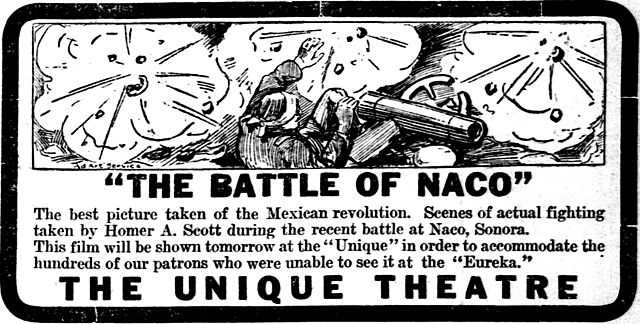Homer Scott
| Homer Scott | |
|---|---|
| Born |
Homer Almariam Scott October 1, 1880 New York City, New York |
| Died |
December 23, 1956 (aged 76) Sacramento, California |
| Occupation | Cinematographer |
| Title | ASC Founding Member (President 1925-1926) |
| Spouse(s) | Mabel L. Upper |
Homer Scott (1 October 1880 – 23 December 1956) was a founding member of the American Society of Cinematographers (A.S.C.) and was their president from 1925-1926. He was also a member and director of its predecessor organization, The Static Club of America.[1]
Mexican Revolution

Little is known of Homer Scott's early work before 1911-1912, when he made several trips from El Paso, Texas into Mexico to photograph and film both sides of the Mexican Revolution. His war photographs were syndicated by Newspaper Enterprise Association, and he also furnished images for the New York Herald, Collier's, and Leslie's Weekly. During one trip, Scott was arrested and nearly executed as a spy.[2] His work is in major collections including the Getty Images and was included in an exhibition titled “Mexico: Photography and Revolution" in 2011 in Mexico City.
He also worked as a staff photographer for the El Paso Herald.[3] In August 1912, Scott traveled to Buffalo, NY, to attend the funeral of his father, William W. Scott,[4] then returned to El Paso.
Early Movies
News items from December 1913 indicate Scott was filming with Buck Connors at Fort Bliss, Texas for the newly formed Albuquerque Film Co.[5] Perhaps the film was The First Law of Nature, a 3-reel film with Dot Farley and Buck Connors which was the Albuquerque Company's first release.[6] Scott's first known cinematography work in Southern California was The Key to Yesterday for Carlyle Blackwell's Favorite Players Film Company in 1914. Scott filmed the four features produced by that company before the company folded in 1915.
For three years Homer Scott was closely associated with director William Desmond Taylor. Scott and Taylor both went from Favorite Players, to American Film,[7] to Pallas-Morosco,[8] to Fox,[9] and back to Pallas-Morosco (which had been absorbed by Famous Players-Lasky).[10] Their collaboration lasted from 1915-1918.
Scott freelanced for several years, and in 1920 filmed noted underwater scenes in Annette Kellerman's What Women Love (1920) and Maurice Tourneur's Deep Waters (1920).
In 1921 Mack Sennett hired Scott as cameraman for Mabel Normand, and Scott filmed her features Molly O (1921), Suzanna (1923), and The Extra Girl (1923), plus other features for Sennett.
Shooting for the Warner Bros.
In 1923 Scott filmed Little Church Around the Corner, Main Street, and Where the North Begins[11] for Warner Brothers.
Disappeared
Scott's name has not been found in the credits of feature films after 1923, but trade publications and publicity items indicate he did camerawork for The Lost World[12] (1925), Tiger Shark[13] (1932), Bird of Paradise (1932), and Below the Sea (1933).[14][15] Harold Lloyd has indicated Scott worked for him as second cameraman.[16]
Selected Filmography
- Davy Crockett (1916)
- Big Timber (1917)
- The Light of Western Stars (1918)
References
- ↑ "The Static Club". Moving Picture World: 273. 10 July 1915. Retrieved 28 December 2013.
- ↑ "El Pasoan in a Mexican Prison: Homer Scott, Held as Spy, Faces Death, Finally Gains Freedom", El Paso Herald, 29 June 1912: 1, retrieved 27 December 2013
- ↑ Arms, Lewis (26 February 1912), "Campa Says Juarez...", El Paso Herald: 3, retrieved 27 December 2013 "...Homer Scott, staff photographer for The Herald..."
- ↑ "Deaths and Burials: W. W. Scott", El Paso Herald, 19 December 1912: 2, retrieved 27 December 2013; also "Died: ...Scott–...", Buffalo Courier, 28 August 1912: 1, retrieved 28 December 2013
- ↑ "Tenth Cavalry Will Soon Appear in the "Movies"", El Paso Herald, 19 December 1913: 16, retrieved 27 December 2013; also "Mimic Battle is Staged for "Movies"", El Paso Herald, 19 December 1913: 2, retrieved 27 December 2013
- ↑ "A New Type of "Westerns"". Motion Picture News: 22. 14 February 1914. Retrieved 26 December 2013.
- ↑ "Director Taylor Makes Record...". Motion Picture News 12 (12): 58. 25 September 1915. Retrieved 26 December 2013. Scott became cameraman on The Diamond From the Sky in August 1915. Taylor had been directing the serial since May 1915, and Scott had been filming features for Lasky prior to rejoining Taylor.
- ↑ "Her Father's Son". Moving Picture World: 380. 21 October 1916. Retrieved 26 December 2013. Pallas Pictures and the Oliver Morosco Photoplay Company used the same studio and personnel, with films distributed by Paramount Pictures.
- ↑ "Pacific Coast Notes: William D. Taylor, the Fox producer...". Motography XVII (6): 327. 10 February 1917. Retrieved 26 December 2013. Other clippings specifically name Scott: "Dustin Farnum in Fox Play"
- ↑ "Homer Scott, the other half of the Taylor-Scott combine...". Moving Picture World: 81. 7 April 1917. Retrieved 26 December 2013.
- ↑ "In Camerafornia". American Cinematographer: 26. May 1923. Retrieved 27 December 2013. The working title "Wolf Fangs" was changed for release to "Where the North Begins."
- ↑ "In Camerafornia". American Cinematographer: 13. December 1924. Retrieved 27 December 2013.
- ↑ "Hunt Shark and Tuna with Camera". The International Photographer: 13. August 1932. Retrieved 27 December 2013.
- ↑ "Even an Octopus was Made to Act in Subsea Film", Washington Post, 30 April 1933
- ↑ Scott, Homer (September 1933). "Strange Perils of Making Movies Beneath the Sea". Modern Mechanix and Inventions: 62–65, 127. Retrieved 27 December 2013.
- ↑ Brownlow, Kevin (1968), "42: Harold Lloyd", The Parade's Gone By..., New York: Alfred A. Knopf, p. 469
External links
- Homer Scott at the Internet Movie Database.
- http://www.getty.edu/research/tools/guides_bibliographies/photography_mexico/photographers.html
- http://www.laht.com/article.asp?ArticleId=376522&CategoryId=13003